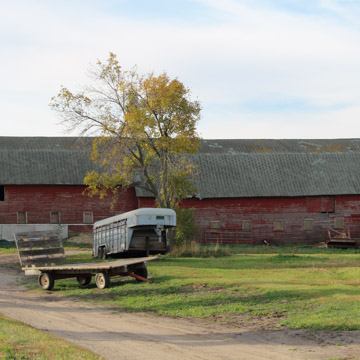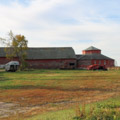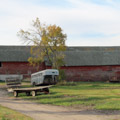G.E. Pettigrew arrived in Flandreau as a child with his family in 1873. Sometime in the late nineteenth century, he established a farm just south of Flandreau. In 1901, Pettigrew introduced registered Herefords (beef cattle) to South Dakota, which he housed in two attached barns: the larger served as the cattle barn, the smaller as a sales barn. Both sit on concrete foundations, are wood-framed with clapboard siding, and have asphalt shingled roofs. The largest barn, located on the east end, has a gambrel roof and a sizeable hayloft. The smaller barn, attached to the west end of the larger barn, is polygonal with a polygonal monitor. Doorways provide access on the west and south elevations of the larger barn and on the west side of the smaller barn. The connection between the two is covered with a gabled roof.
The barns exemplify the types of farm outbuildings associated with cattle operations in eastern South Dakota. In 1914 J.M. Pettigrew, G.E.’s son, helped build a champion herd. Ron and Gloria Severtson entered into partnership with the younger Pettigrew in the 1950s, and continued to build on the reputation of the Pettigrew cattle. In the mid-1960s, the Severtsons became full owners of the herd, and sold stock internationally, as well as throughout the country. Stock sales were held weekly in the polygonal barn through the 1980s. Both barns are still in use, although the polygonal barn is now used as a calving barn rather than a sale barn.

















